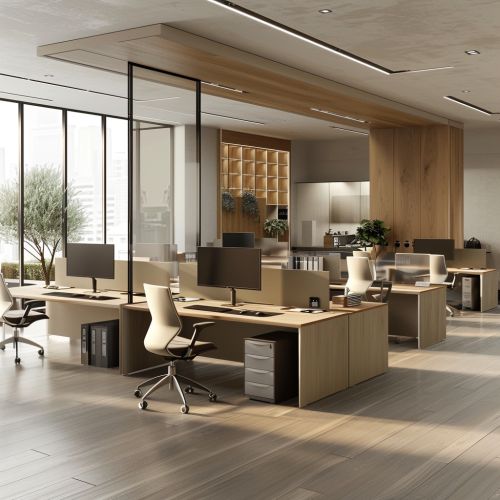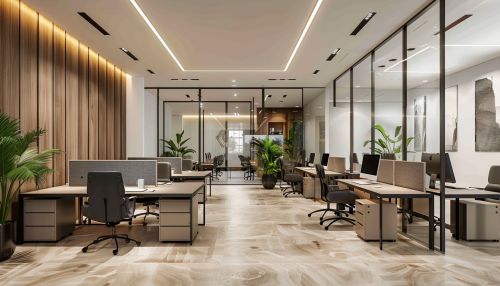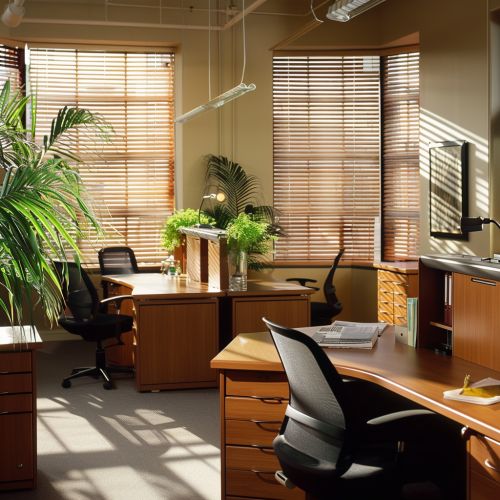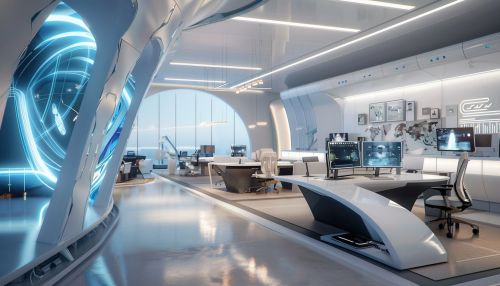Office Spaces
Overview
An office space is a physical area, typically within a building, that is designated for work-related activities. It serves as a place where employees can perform their tasks, collaborate with colleagues, and contribute to the overall productivity of an organization. Office spaces can vary greatly in size, design, and layout, depending on the nature of the work, the size of the organization, and the culture of the workplace.


History
The concept of office spaces dates back to the Roman Empire, where large administrative buildings known as basilicas were used for business transactions and other official duties. However, the modern office space as we know it today began to take shape during the Industrial Revolution.
Industrial Revolution
The Industrial Revolution in the 18th and 19th centuries saw a shift from small-scale, home-based businesses to large-scale factories and corporations. This shift necessitated the creation of dedicated spaces where administrative work could be carried out. These early office spaces were often large, open rooms filled with desks where clerks and other office workers could carry out their duties.
20th Century
The 20th century brought significant changes to the design and function of office spaces. The advent of the typewriter, the telephone, and later, the computer, transformed the way work was carried out, leading to the need for more specialized office spaces. This era also saw the rise of the cubicle, a semi-private workspace designed to provide employees with a degree of privacy while maximizing the use of space.
Types of Office Spaces
There are several types of office spaces, each designed to meet different needs and work styles. These include traditional offices, open offices, co-working spaces, and home offices.
Traditional Offices
Traditional offices, also known as closed offices, consist of a series of individual rooms or offices along a corridor. Each room is typically occupied by one or two employees, providing them with privacy and a quiet environment in which to work. This type of office space is often used by professionals who require a high degree of concentration or confidentiality in their work, such as lawyers, doctors, or executives.
Open Offices
Open offices are characterized by a lack of interior walls or partitions, resulting in a large, open space where employees work together. The idea behind this design is to promote collaboration and communication among employees. However, open offices have been criticized for their lack of privacy and potential for noise and distractions.
Co-working Spaces
Co-working spaces are shared workspaces where individuals or small businesses can rent desks or offices on a short-term basis. These spaces often provide amenities such as internet access, printing services, and meeting rooms. Co-working spaces are popular among freelancers, remote workers, and startups due to their flexibility and networking opportunities.
Home Offices
Home offices are workspaces set up in a person's residence. With the rise of remote work and telecommuting, more people are setting up home offices to provide a dedicated space for work within their homes. A home office can be as simple as a desk in a spare room or as elaborate as a custom-built workspace.
Design and Layout
The design and layout of an office space can have a significant impact on employee productivity, satisfaction, and well-being. Factors to consider include space planning, furniture selection, lighting, acoustics, and aesthetics.


Space Planning
Space planning involves determining how to best use the available space in an office. This includes deciding on the placement of workstations, meeting rooms, break areas, and other facilities. A well-planned office space can improve workflow, facilitate communication, and create a more comfortable and efficient work environment.
Furniture Selection
Choosing the right furniture is crucial for creating a comfortable and productive office space. This includes desks, chairs, storage units, and other furnishings. Ergonomic furniture, which is designed to support the body and reduce discomfort during long periods of sitting, is particularly important in preventing work-related injuries.
Lighting
Lighting plays a key role in creating a comfortable and productive office environment. Good lighting can reduce eye strain, improve mood, and increase productivity. Natural light is particularly beneficial, but artificial lighting can also be used effectively.
Acoustics
Acoustics refers to how sound behaves in an office space. Poor acoustics can lead to excessive noise, which can be distracting and stressful for employees. Sound-absorbing materials and strategic space planning can help improve the acoustics of an office.
Aesthetics
The aesthetics of an office space, including color schemes, artwork, and overall design, can impact employee morale and productivity. A well-designed office can create a positive work environment and reflect the company's culture and values.
Future Trends
The future of office spaces is likely to be influenced by technological advancements, changing work patterns, and a greater focus on employee well-being. Trends to watch for include flexible workspaces, sustainable design, and the integration of technology.


Flexible Workspaces
Flexible workspaces, which can be easily reconfigured to accommodate different tasks and work styles, are becoming increasingly popular. This trend is driven by the growing recognition of the need for flexibility and adaptability in the workplace.
Sustainable Design
Sustainable design involves creating office spaces that are environmentally friendly and energy-efficient. This can include using sustainable materials, incorporating natural light, and implementing energy-saving technologies.
Integration of Technology
The integration of technology into office spaces is a trend that is likely to continue. This can include the use of advanced communication tools, smart furniture, and other technologies that enhance productivity and collaboration.
